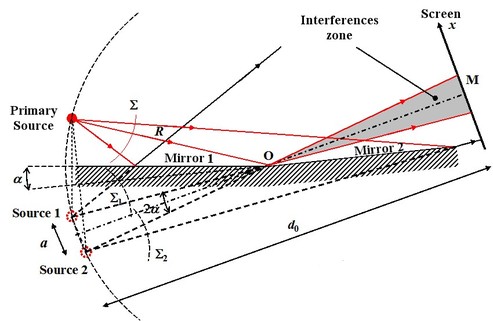
Fresnel mirrors
This device uses a primary source combined with two reflecting plan mirrors that make a slight angle
 between their planes. Their source is located at the distance
between their planes. Their source is located at the distance
 on the mirror's edge. Each mirror gives a virtual image of the primary source and both images act as secondary sources. In the intersection area of both beams we can observe interferences. Figure 2 presents the Fresnel mirrors device.
on the mirror's edge. Each mirror gives a virtual image of the primary source and both images act as secondary sources. In the intersection area of both beams we can observe interferences. Figure 2 presents the Fresnel mirrors device.

We demonstrate geometrically that the secondary sources are used on a circle with center
 and radius
and radius
 . The screen is placed at the distance
. The screen is placed at the distance
 from the secondary sources, parallel to the sources plane. The secondary sources are quantity
from the secondary sources, parallel to the sources plane. The secondary sources are quantity
 away . We recognize that we have to process the interferences between two spherical wavefronts emitted by both secondary sources. . In all point
away . We recognize that we have to process the interferences between two spherical wavefronts emitted by both secondary sources. . In all point
 , the interferences are written
, the interferences are written
And in the case of the parabolic approximation where
 ,
,
As the angle
 is small, we have the triangle
is small, we have the triangle
 :
:
So comes :
And the interfringe is :
To define the fringes's geometric shape, we will determine the place of the points for which the phase is constant, which leads to
 , as the other magnitudes are set by the circuitry geometry. The fringes are vertical, perpendicular to the figure plane, and regularly spaced from the interfringe
, as the other magnitudes are set by the circuitry geometry. The fringes are vertical, perpendicular to the figure plane, and regularly spaced from the interfringe
 .
.